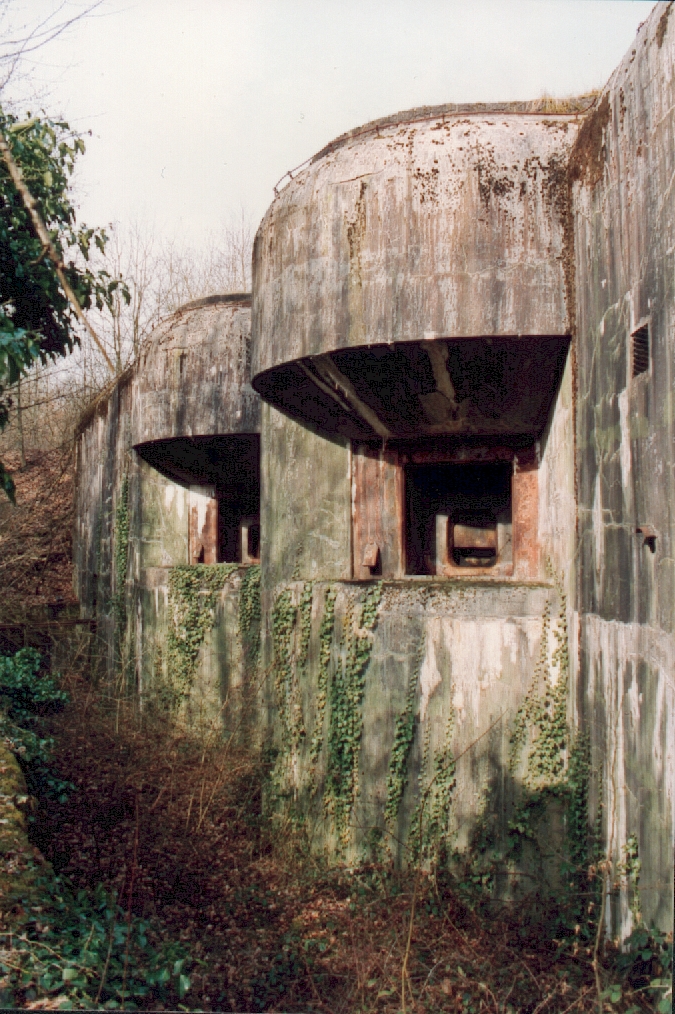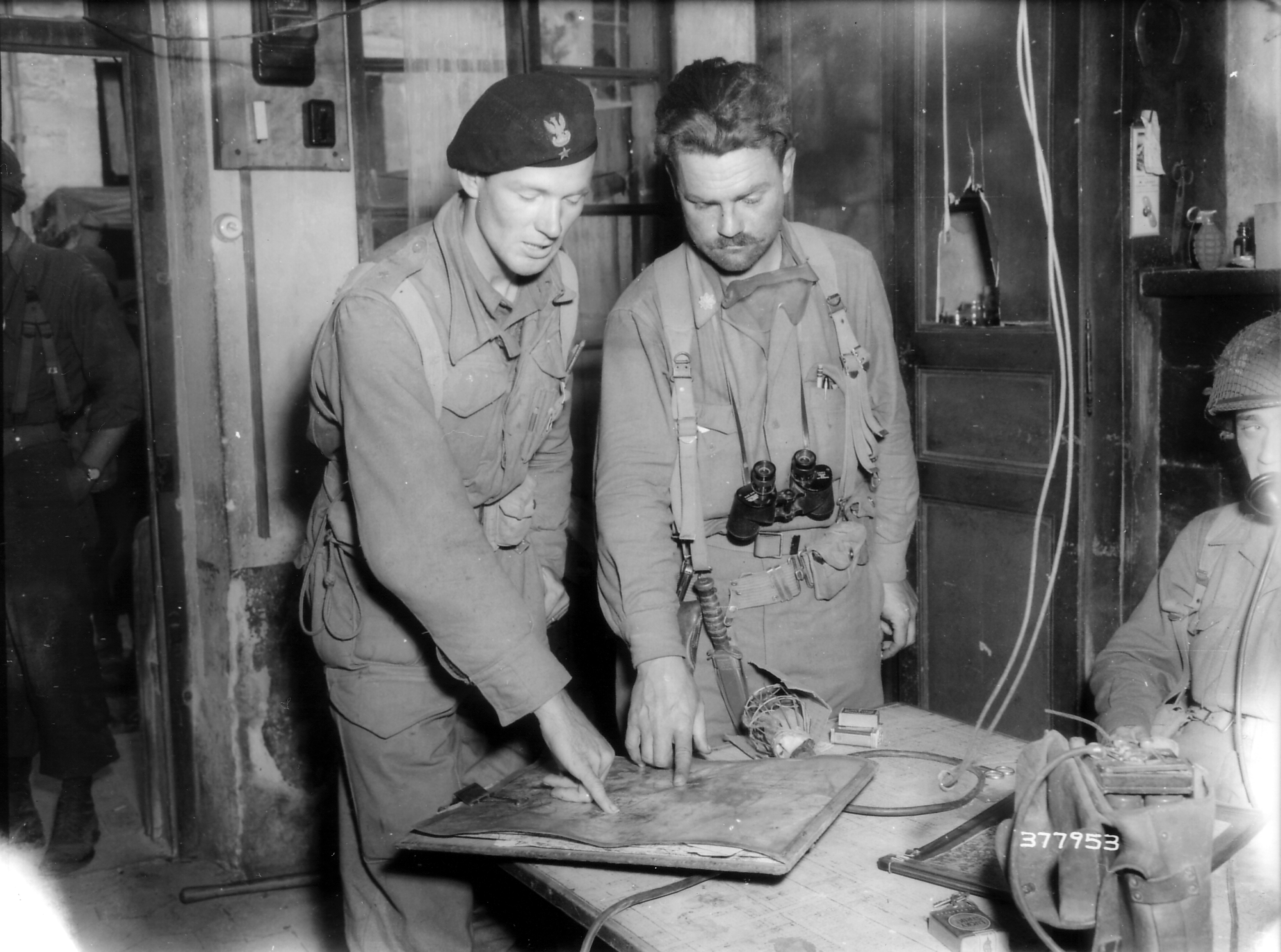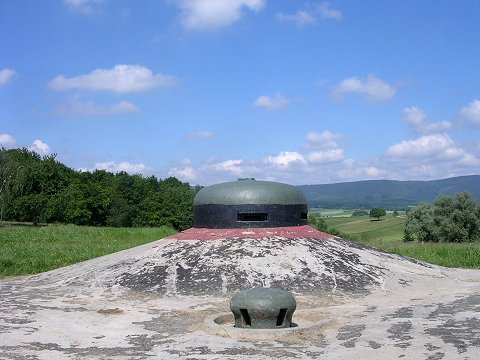|
Ouvrage Billig
Ouvrage Billig, a ''gros ouvrage'' or large fortification of the Maginot Line, was located in the Fortified Sector of Thionville, Moselle in northern France. It is located between the ''gros ouvrages'' Metrich and Hackenberg, facing Germany. It saw relatively little action during World War II and after a period of reserve duty in the 1950s, was abandoned in the 1970s. Design and construction Billig was approved for construction by CORF (''Commission d'Organisation des Régions Fortifiées''), the Maginot Line's design and construction agency, in June 1930 and became operational by 1935,Kaufmann 2006, p. 25 at a cost of 65 million francs. The contractor was Ossude of Paris.Mary, Tome 1, p. 52 Description This ''gros ouvrage'' is unusual in having one entrance for both ammunition and personnel. It lacks the large "M1" magazine of other ''gros ouvrages''. The dogleg-shaped layout is relatively short for a ''gros ouvrage'', with less than of underground gallery at an average d ... [...More Info...] [...Related Items...] OR: [Wikipedia] [Google] [Baidu] |
Maginot Line
The Maginot Line (french: Ligne Maginot, ), named after the French Minister of War André Maginot, is a line of concrete fortifications, obstacles and weapon installations built by France in the 1930s to deter invasion by Germany and force them to move around the fortifications. The Maginot Line was impervious to most forms of attack. In consequence, the Germans invaded through the Low Countries in 1940, passing it to the north. The line, which was supposed to be fully extended further towards the west to avoid such an occurrence, was finally scaled back in response to demands from Belgium. Indeed, Belgium feared it would be sacrificed in the event of another German invasion. The line has since become a metaphor for expensive efforts that offer a false sense of security. Constructed on the French side of its borders with Italy, Switzerland, Germany, Luxembourg and Belgium, the line did not extend to the English Channel. French strategy therefore envisioned a move into Belgium ... [...More Info...] [...Related Items...] OR: [Wikipedia] [Google] [Baidu] |
LG Cloche
The LG cloche was a defensive element common to many Maginot Line ''ouvrages''. The fixed cupola was deeply embedded into the concrete on top of a combat block, with only the top surface visible. The opening permitted the ejection of grenades from the interior of the cloche, providing a means of close defense against enemy troops on top of the bunker. 75 units were installed in the Maginot Line. LG refers to ''Lance-Grenade'' (grenade launcher). Unlike other cloches such as the GFM or the JM, the LG cloche was effectively "blind", possessing a single shuttered orifice in diameter in its flat crown. It had no observation ports at all, as it did not project appreciably above the surrounding surface. The LG cloche came in three models: a small version, high, a large version, and a cloche for two persons, tall. All were in diameter. LG cloches were usually found in the vicinity of an entrance block. The LG cloche was armed with a grenade launcher that could fire at an angle f ... [...More Info...] [...Related Items...] OR: [Wikipedia] [Google] [Baidu] |
Atlantic Wall
The Atlantic Wall (german: link=no, Atlantikwall) was an extensive system of coastal defences and fortifications built by Nazi Germany between 1942 and 1944 along the coast of continental Europe and Scandinavia as a defence against an anticipated Allied invasion of Nazi-occupied Europe from the United Kingdom, during World War II. The manning and operation of the Atlantic Wall was administratively overseen by the German Army, with some support from ''Luftwaffe'' ground forces. The ''Kriegsmarine'' (German Navy) maintained a separate coastal defence network, organised into a number of sea defence zones. Hitler ordered the construction of the fortifications in 1942 through his Führer Directive No. 40. More than half a million French workers were drafted to build it. The wall was frequently mentioned in Nazi propaganda, where its size and strength were usually exaggerated. The fortifications included colossal coastal guns, batteries, mortars, and artillery, and thousands o ... [...More Info...] [...Related Items...] OR: [Wikipedia] [Google] [Baidu] |
Siegfried Line
The Siegfried Line, known in German as the ''Westwall'', was a German defensive line built during the 1930s (started 1936) opposite the French Maginot Line. It stretched more than ; from Kleve on the border with the Netherlands, along the western border of Nazi Germany, to the town of Weil am Rhein on the border with Switzerland – and featured more than 18,000 bunkers, tunnels and tank traps. From September 1944 to March 1945 the Siegfried Line was subjected to a large-scale Allied offensive. Name The official name for the German defensive line construction program before and during the Second World War that collectively came to be known as the "Westwall" (and "Siegfried Line", or sometimes "West Wall", in English) changed several times during the late 1930s reflecting areas of progress. * Border Watch programme (pioneering programme) for the most advanced positions (1938) * Limes Programme (1938) * Western Air Defense Zone (1938) * Aachen–Saar Programme (1939) * Ge ... [...More Info...] [...Related Items...] OR: [Wikipedia] [Google] [Baidu] |
List Of Maginot Line Ouvrages
Here is the list of all ''ouvrages'' of the Maginot Line, organized by sector and type of fortification. ''Ouvrage'' translates as "works" in English: published documents in both English and French refer to these fortifications in this manner, rather than as "forts". An ''ouvrage'' typically consists of a series of concrete-encased strongpoints, linked by tunnels. For a list of the ''ouvrages'' of the Alpine Line, or Little Maginot Line, see List of Alpine Line ouvrages. Belgian border Fortified Sector of Flanders Fortified Sector of Lille Fortified Sector of the Escaut Ouvrage * Ouvrage d'Eth Casemates * Casemate de Tallandier * Casemate de Jeanlain * Casemate de Notre Dame d'Amour * Casemate du Mont des Bruyères * Casemate de la Ferme des Rosières * Casemate de Marlières * Casemate de Haute Rive * Casemate de Drève St Antoine * Casemate de Lièvre Ouest * Casemate de Lièvre Est * Casemate de Trieux d'Escaupont Ouest * Casemate de Trieux d'Escaup ... [...More Info...] [...Related Items...] OR: [Wikipedia] [Google] [Baidu] |
GO Billig - EM - 30-10-04 - 21
Go, GO, G.O., or Go! may refer to: Arts and entertainment Games and sport * Go (game), a board game for two players * ''Travel Go'' (formerly ''Go – The International Travel Game''), a game based on world travel * Go, the starting position located at the corner of the board in the board game ''Monopoly'' * ''Go'', a 1992 game for the Philips CD-i video game system * ''Go'', a large straw battering ram used in the Korean sport of Gossaum * Go!, a label under which U.S. Gold published ZX Spectrum games * Go route, a pattern run in American football * ''Go'' series, a turn-based, puzzle video game series by Square Enix, based on various Square Enix franchises * '' Counter-Strike: Global Offensive'' (''CS:GO''), a first-person shooter developed by Valve * '' Pokémon Go'', an augmented reality game Film * ''Go'' (1999 film), American film * ''Go'' (2001 film), a Japanese film * ''Go'' (2007 film), a Bollywood film * ''Go Karts'' (film), an Australian film also titled as ''G ... [...More Info...] [...Related Items...] OR: [Wikipedia] [Google] [Baidu] |
Warsaw Pact
The Warsaw Pact (WP) or Treaty of Warsaw, formally the Treaty of Friendship, Cooperation and Mutual Assistance, was a collective defense treaty signed in Warsaw, Poland, between the Soviet Union and seven other Eastern Bloc socialist republics of Central and Eastern Europe in May 1955, during the Cold War. The term "Warsaw Pact" commonly refers to both the treaty itself and its resultant defensive alliance, the Warsaw Treaty Organization (WTO). The Warsaw Pact was the military complement to the Council for Mutual Economic Assistance (Comecon), the regional economic organization for the socialist states of Central and Eastern Europe. The Warsaw Pact was created in reaction to the integration of West Germany into the North Atlantic Treaty Organization (NATO)"In reaction to West Germany's NATO accession, the Soviet Union and its Eastern European client states formed the Warsaw Pact in 1955." Citation from: in 1955 as per the London and Paris Conferences of 1954.The Warsaw Pact R ... [...More Info...] [...Related Items...] OR: [Wikipedia] [Google] [Baidu] |
90th Infantry Division (United States)
The 90th Infantry Division ("Tough 'Ombres") was a unit of the United States Army that served in World War I and World War II. Its lineage is carried on by the 90th Sustainment Brigade. World War I *Activated: August 1917. *Overseas: June 1918. *Major Operations: St. Mihiel, Meuse-Argonne. *Casualties: Total-7,549 (KIA-1,091; WIA-6,458). *Commanders: Maj. Gen. Henry T. Allen (25 August 1917), Brig. Gen. Joseph A. Gaston (23 November 1917), Brig. Gen. William Johnston Jr. (27 December 1917), Maj. Gen. Henry T. Allen (1 March 1918), Brig. Gen. Joseph P. O'Neil (24 November 1918), Maj. Gen. Charles H. Martin (30 December 1918). *Returned to U.S. and inactivated: June 1919. Order of battle * Headquarters, 90th Division * 179th Infantry Brigade ** 357th Infantry Regiment ** 358th Infantry Regiment ** 344th Machine Gun Battalion * 180th Infantry Brigade ** 359th Infantry Regiment ** 360th Infantry Regiment ** 345th Machine Gun Battalion * 165th Field Artillery Brigade ** 343rd Fie ... [...More Info...] [...Related Items...] OR: [Wikipedia] [Google] [Baidu] |
Second Armistice At Compiègne
The Armistice of 22 June 1940 was signed at 18:36 near Compiègne, France, by officials of Nazi Germany and the Third French Republic. It did not come into effect until after midnight on 25 June. Signatories for Germany included Wilhelm Keitel, a senior military officer of the Wehrmacht (the German armed forces), while those on the French side held lower ranks including General Charles Huntziger. Following the decisive German victory in the Battle of France (10 May – 21 June 1940) during World War II, this armistice established a German occupation zone in Northern and Western France that encompassed about three fifths of France's European territory, including all English Channel and Atlantic Ocean ports. The remainder of the country was to be left unoccupied, although the new regime which replaced the Third Republic was mutually recognized as the legitimate government of all of Metropolitan France except Alsace-Lorraine. The French were also permitted to retain control of a ... [...More Info...] [...Related Items...] OR: [Wikipedia] [Google] [Baidu] |
Wehrmacht
The ''Wehrmacht'' (, ) were the unified armed forces of Nazi Germany from 1935 to 1945. It consisted of the ''Heer'' (army), the ''Kriegsmarine'' (navy) and the ''Luftwaffe'' (air force). The designation "''Wehrmacht''" replaced the previously used term and was the manifestation of the Nazi regime's efforts to rearm Germany to a greater extent than the Treaty of Versailles permitted. After the Nazi rise to power in 1933, one of Adolf Hitler's most overt and audacious moves was to establish the ''Wehrmacht'', a modern offensively-capable armed force, fulfilling the Nazi régime's long-term goals of regaining lost territory as well as gaining new territory and dominating its neighbours. This required the reinstatement of conscription and massive investment and defense spending on the arms industry. The ''Wehrmacht'' formed the heart of Germany's politico-military power. In the early part of the Second World War, the ''Wehrmacht'' employed combined arms tactics (close-cover ... [...More Info...] [...Related Items...] OR: [Wikipedia] [Google] [Baidu] |
VDP Cloche
The VDP cloche was an element of the Maginot Line fortifications. A ''cloche'' (bell) was a fixed and non-retractable firing position made of a thick iron casting which shielded its occupant. By comparison, turrets could be rotated and sometimes lowered so that only the top shell was exposed. VDP cloches were used for observation of the surrounding area for artillery direction. VDP is an acronym for ''Vision Directe et Périscopique''. By comparison with the GFM cloche, the VDP cloche had narrower ports and was consequently lower in profile. Description VDP cloches were equipped with three embrasures or crenels for direct vision, providing protection to observers. VDP cloches were also equipped with periscopes that allowed a greater arc of view. The cloches were embedded in a thick concrete carapace over a combat, entrance or observation block element of a largely subterranean Maginot fortification. A platform, identical to that used in the GFM cloche, was installed for the obser ... [...More Info...] [...Related Items...] OR: [Wikipedia] [Google] [Baidu] |
GFM Cloche
The GFM cloche was one of the most common defensive armaments on the Maginot Line. A ''cloche'' (bell) was a fixed and non-retractable firing position made of a thick iron casting which shielded its occupant. By comparison, turrets could be rotated and sometimes lowered so that only the top shell was exposed. GFM is an acronym for ''Guetteur et Fusil-Mitrailleur'' (lookout and rifle-machine-gunner), which describes its purpose as a lookout and firing position for light weapons. Most of the bunkers or blocks in a Maginot Line ''ouvrage'' were fitted with several fixed armoured cupolas or cloches. The cupolas were designed to allow the soldiers to perform reconnaissance or repel an attack with an absolute maximum of cover, from inside the bunker. The armament of each cloche varied significantly, but were typically equipped with some combination of: * Light machine guns or automatic rifles * Vision blocks * Mounted binoculars * A periscope (located on the top of the bell) * A 50&nbs ... [...More Info...] [...Related Items...] OR: [Wikipedia] [Google] [Baidu] |







